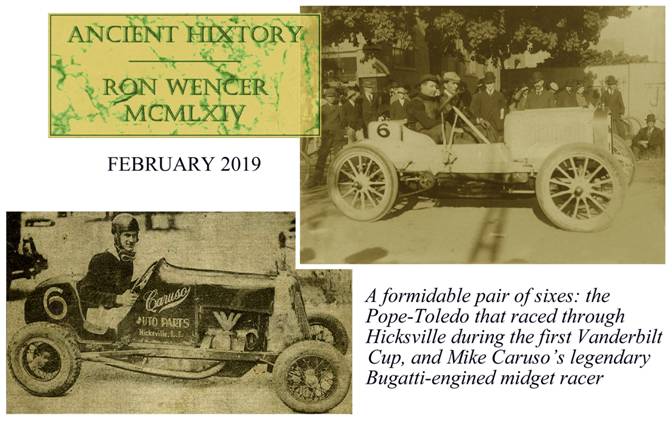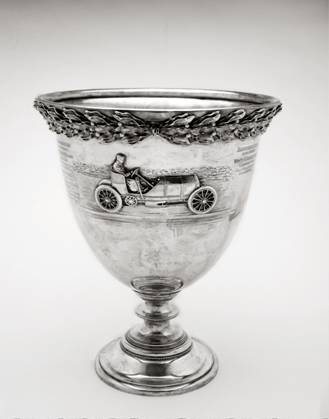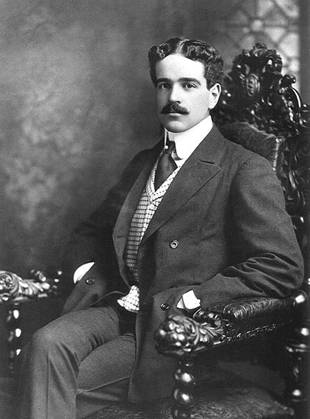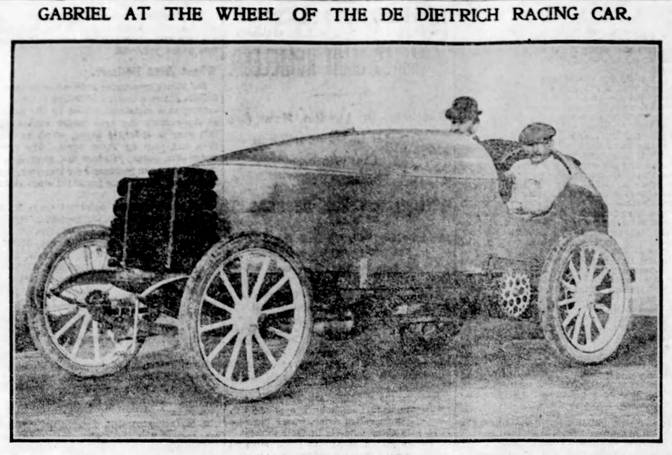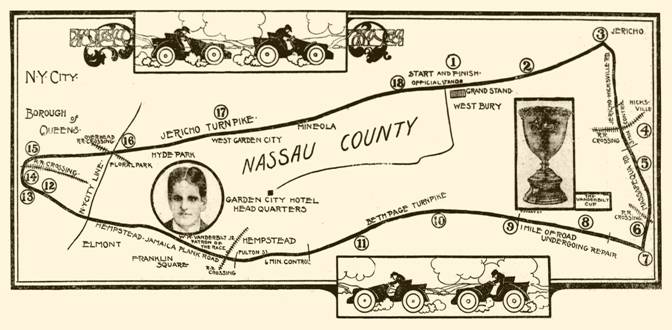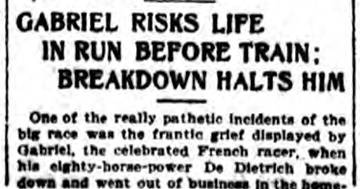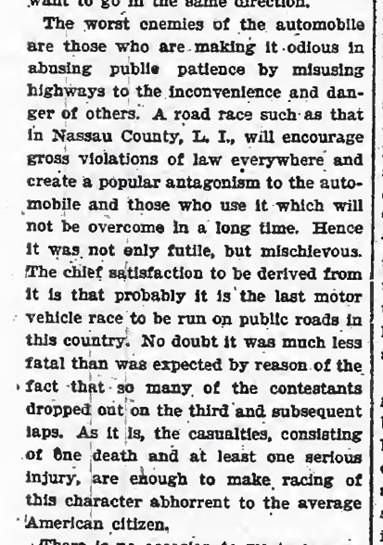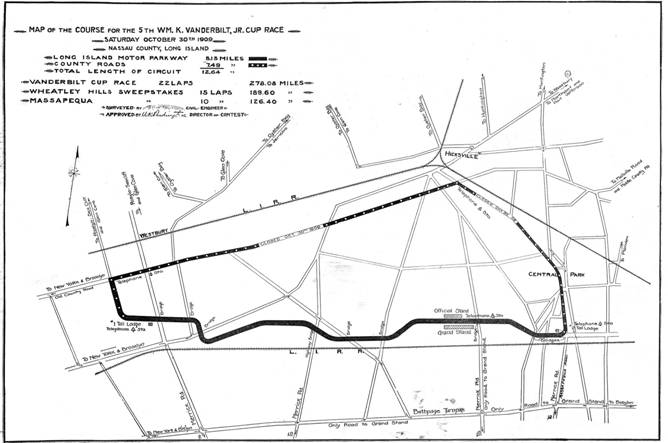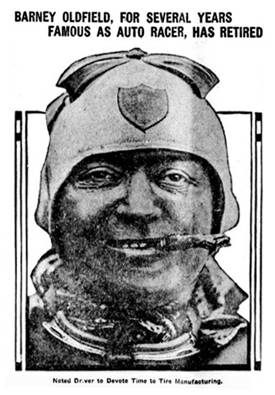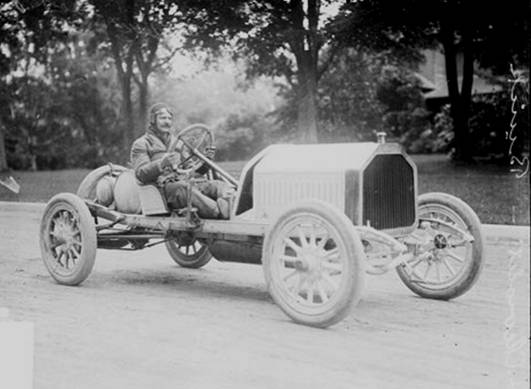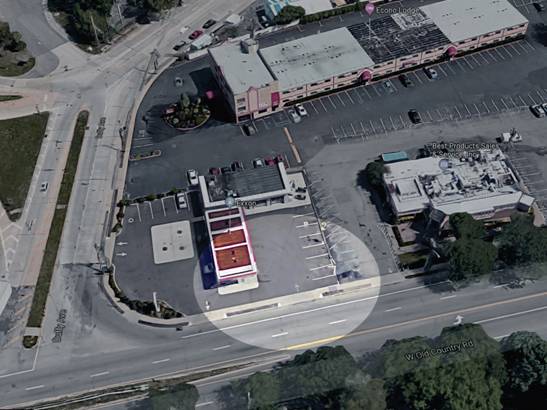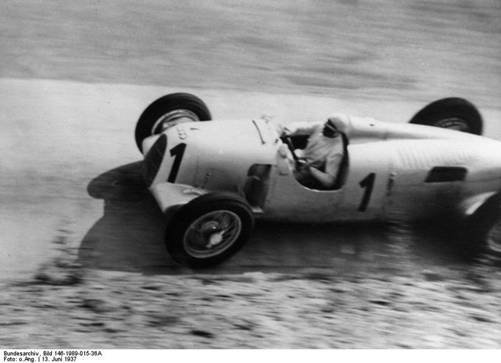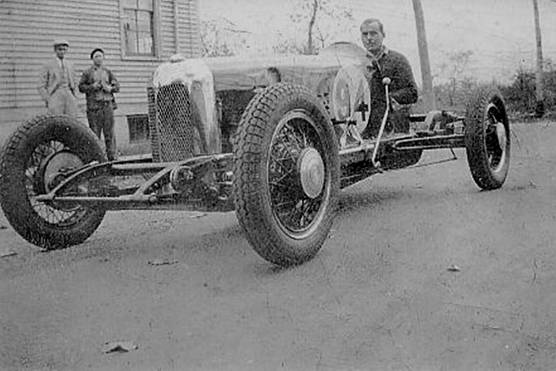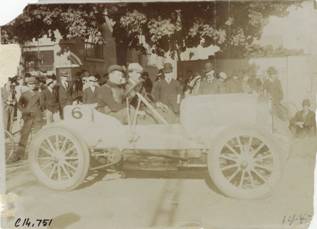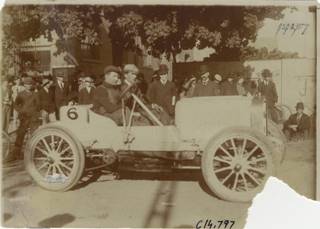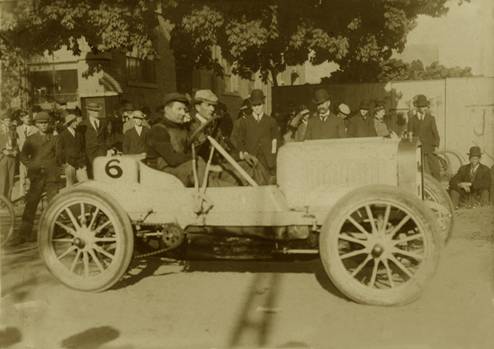|
Open Wheels, Dirt, &
Speed
Pope-Toledo photo
Courtesy of the National Automotive History Collection, Caruso
photo from www.carusomidgetracing.com/racing-photos.html As
we've seen here recently, early 1900s life was not always slow for the
people of dusty This
is the first part of an Ancient
Hixtory article devoted to The
next part of this article, to appear in April's Ancient Hixtory, will look at different men.
Resourceful, ingenious, and dedicated, they worked to create a
world of racing for powerful but small cars.
Among them we will find Mike Caruso, a man who put down roots in *** The
Vanderbilt Cup Races In 1900, William Kissam Vanderbilt
Junior was 22 years old, and heir to an immense fortune.
He was also fascinated by fast cars.
He became convinced that American automobiles of the day were
inferior to those of
"Willie K," as his friends called
him, knew speed first-hand. In
January 1904, he set a new world record, driving his Mercedes
for a mile on the sands near Daytona at an average of 92.3 mph.
Tiffany and Co. depicted that feat on the trophy it created for
the fruit of Vanderbilt's musings, the Vanderbilt Cup Races, the first
of which rolled right through *** The
1904 Race State
of the Art In 1904, breakdowns were to be
expected. The automobiles of
the era were not reliable, and driving them long distances over rough
roads at high speed made things worse.
Thus, a race car had to carry a "mechanician." The Ford Motor Company was one year
old, and the Model T still
four years in the future, but other automakers were on the scene.
Only a few of those who supplied cars for the Vanderbilt Cup Race
exist today: FIAT, Renault, and Mercedes (no Benz
yet). The cars were not
standard models; each had unique quirks.
This uniqueness made the men in the passenger seats
indispensable. As they rode,
they were vigilant, listening and watching for any hint of problems.
They had stocked their toolboxes beforehand, trying to be ready
for anything they might need as the hundreds of miles sped by.
The The vehicles were fast, heavy, and
clumsy, with high centers of gravity.
Little was known about designing suspensions that could keep them
upright and controllable. Ruts
in dirt roads, excessive cornering speed, or blown tires could cause
roll-overs that threw or crushed the men in the cars to their deaths.
Even if nothing went wrong with a car, its mechanician might be
momentarily distracted by a problem, relax his grip on the car, and get
bounced headfirst to the ground. Spectators fared as poorly.
Despite frequent newspaper reports of cars' striking onlookers
at races, the public refused to believe that standing at the edge of -
or even on - the course, as close as possible to the trajectory of an
approaching car, was a bad idea. What
could go wrong? Anything.
More than once, a punctured tire diverted a ton of speeding steel
towards a cluster of spectators. The
Course The race consisted of 10 clockwise laps
around a 30.24 mile course, almost triangular in shape.
The points of the triangle were
The There were railroad crossings.
At Hempstead and The newspaper story excerpted below
relates how an LIRR train was cleared to proceed through a crossing
during the race, and promptly almost hit a speeding auto that failed to
stop for inspection. This
was not a matter of recklessness; the car's brake lines had failed as
it approached the control. So
as not to collide with the train, the driver sped in front of the moving
locomotive, with a very few feet to spare.
Once safely beyond the crossing, he slowed and coasted to a stop,
his race finished.
A
Fatality During the second lap of the race, the Mercedes
of driver George Arendt blew a tire at high speed near Top
Finishers After about five and one-half hours,
the contest ended very abruptly (see notes below).
French cars held the two highest spots, followed by an American
car. The winning driver was
described by the press as "an American millionaire."
*To
calculate average speed, one must exclude both the time spent not racing
in the controls, and the distance driven in the controls.
The speeds above were calculated from the published times and an
adjusted race length of 284.4 miles. **When
Heath's Panhard finished his last lap, no car still racing could
possibly beat his time except one - the Clement-Bayard.
As soon as Clement's final time was posted, the spectators saw
that Heath had won, and they ran down from the grandstand, flooding the
track. With the remaining
contestants still racing towards the finish, Willie K desperately ran
amongst the people, urging them to clear the course for their own
safety. Quick-thinking
officials telephoned others stationed around the track, stopping the
race immediately. The
standings from third place down were assigned according to where cars
stood at that time. Albert Clement's time made his the
closest second-place finish of any international road race to date, but
Heath's approach to the race had kept Clement closer than he might
have been. Heath tried to
balance his pace against the limits of his Panhard's endurance,
driving only as fast as required to maintain first place.
This strategy proved wise; another Panhard driver went all-out
from the start. He recorded
the fastest lap of the race - but during the fourth lap, his car's
clutch failed, and his race was over. Some highlights of the race can be
viewed on several YouTube
postings, including this one: https://www.youtube.com/watch?v=zYoA4aTTyCE *** Beyond
1904 The race over, it was time for
Vanderbilt to revise his plans, for there had been many problems. The track record (no pun intended) of
European road racing was rife with serious injuries and fatalities, with
respect both to spectators and participants.
Casualties seemed to be unavoidable.
A number of people feared that the Vanderbilt Races had brought
the same problem to the
New York Times Editorial, October 9, 1904 Furthermore, closing public roads for
such an event had been met with legal challenges.
Some were based on individual cases (i.e., people whose
businesses or lives had been impacted by road closures).
Others were based on more abstract issues, e.g. should
taxpayer-funded public roads ever be closed so that wealthy
non-residents could race? There also had been ugly, unspoken
objections. The night before
the race, nails had been sprinkled on the track near the starting area,
causing numerous tire punctures. Worse,
a rifle had been fired blindly into a barn used as headquarters for one
of the racing teams; no one was injured, and the car was not
significantly affected. Apparently,
people in the "good old days" were not always innocent and kind. Willie K realized that the differences
between That was true in another way, too.
American country roads, although newer by millennia than their
European counterparts, were often unsuitable for ordinary driving, let
alone for racing. Hoping to
stir public support for road improvements, Vanderbilt undertook
construction of the Long Island
Motor Parkway, relics of which survive today.
Some of it was used later in the Cup Race series, as a safer
alternative to public roads along the southern leg of the courses. *** Return
to The
Course Note that I deliberately ended the
previous paragraph with the word "courses," plural.
The road to the Vanderbilt Cup changed almost annually.
The race did not return to the streets of
www.vanderbiltcupraces.com The northern leg of the new route was
Old Country Road, the eastern leg was Broadway (the modern Route 107),
the southern leg incorporated sections of the new Motor Parkway, and the
western leg was (I think) along or near Glen Cove Road.
The grandstand was on the southern leg, and - unlike in 1904
- the course was driven counter-clockwise. The revised course did not cross any
LIRR tracks, and there were no "controls."
A shorter course meant fewer roads to close, fewer legal
disputes, etc. The reason
most often given for shortening the course was that having more and
quicker laps offered spectators a better experience.
From a single spot, people saw the cars more times and at shorter
intervals; there were few lulls. Attendance
each year topped one-quarter million. A
Different State of the Art The automobile now was a more familiar
part of American culture than in 1904.
Auto racing had acquired a broader fan base, one which was less
interested in exotic cars. The
country's affair with stock-car racing had begun.
Racer versions of production American cars now competed all over
the country, usually on ovals, driven by men like Barney Oldfield, whom
the public idolized.
Swiftly navigating a series of curves
now was appreciated less than pure speed.
Compared to road racing, both drivers and cars had to be agile in
a different way. Oldfield
embraced the change, and he took it to an extreme.
He had "observed" a Cup race "to see what he could
learn," but afterwards he returned to ovals and pure speed pursuits.
Eventually, he forsook sanctioned auto racing completely, opting
instead for one-man events, like speed record attempts, or one-on-one
challenges. Once, he even
raced a car against a biplane. Willie K must have been conflicted
about these developments. He
had wanted the excitement of road racing to promote innovative
engineering, leading to improvements both in racing and pleasure
driving. Now, the racing
public was understandably caught up in the moment, cheering for American
cars with familiar names. Deep
down, the cars they saw on the track were pretty much the same as the
ones in their own garages, right? A
Family of Races In 1909 and 1910, each race was three
races in one. The most
powerful cars competed for the Vanderbilt Cup, and raced for all 22
laps. In the same race, cars
with slightly smaller engines competed in the Wheatley
Hills Sweepstakes, but ended their race after 189 miles (15 laps).
Cars with still smaller engines competed in the Massapequa Sweepstakes, racing only for the first 126 miles (10
laps). This arrangement might seem to suggest
that the Vanderbilt Cup cars would have the course to themselves for
about 7 laps of the race, but that was not necessarily true.
The laps driven by the smaller, slower cars took more minutes to
complete. For example, when
1909's last Wheatley car completed 15 laps, the fastest Cup car had
only 4.5 of its 22 laps - 20% of the race - left.
For 80% of the Cup race, its driver had had to work his way
around the slower car(s). Carnage In both 1909 and 1910, the winner of
the Vanderbilt Cup was Harry Grant, steadily driving the ALCO Black Beast at average speeds well over 60 mph.
In the public eye, however, casualties ultimately overshadowed
the racing achievements of Grant and the other participants. Unlike the 1904 race, the 1909 contest
incurred no fatalities. However,
two Wheatley Sweepstakes
competitors had major accidents. Both
crashed into telegraph poles while rounding the Massapequa Corner, with
one of the cars also breaking a spectator's leg. 1910 was much worse.
In Swiss driver Louis Chevrolet (yes, the
man after whom today's Chevrolets are named) competed in 1909, scoring
the fastest lap at 76.3 mph, but his Marquette-Buick broke down, and he
did not finish. He and the
car returned in 1910.
From Wikipedia Chicago Daily News negatives collection, DN-0003451 Courtesy of the Quickly taking the lead, he was forced
to pit by a magneto problem. Once
back in the race, he again worked his way into first place.
On the fourteenth lap, the Marquette-Buick hit a rut in
modified from Google Maps image The night before, there had been two serious
non-race accidents on The stigma was too much to overcome.
In subsequent years, the event went to *** Another
Vanderbilt's Races In 1936 and 1937, George Washington Vanderbilt,
Willie K's nephew, sponsored races on a course built on the Roosevelt
Raceway grounds. A new cup
was won, one year by Tazio Nuvolari in an Alfa-Romeo prepared by Scuderia
Ferrari, and the next by Bernd Rosemeyer in the legendary
Auto-Union.
Bernd
Rosemeyer driving Auto Wikipedia
(Italian Edition) Public reaction was lukewarm, and the series was
discontinued. *** Epilogue Before closing this installment, let's look ahead. American and European interests in
racing differed. A Barney
Oldfield, for example, had no interest in driving cars around a twisty
course full of corners; he wanted to go as fast as possible.
Most European drivers thought (mistakenly) that there was no
challenge in racing on ovals. The
right kind of man, however, might be sufficiently open-minded and
creative to find ways of fitting together pieces of both worlds. In the next part of the story, we
follow American racing as it branches out, and we also follow the career
of one man in particular, Mike Caruso: born in
Mike Caruso in the car he built in 1929 for American sprint races, utilizing a British Riley engine www.carusomidgetracing.com/racing-photos.html "Exotic car" purists would cringe
if they looked back to the beginning of this article, and saw driver
Johnny Duncan in Mike Caruso's midget #6.
To make this car, Mike did something truly impressive (and
perhaps to some, sacrilegious): he sliced the block of an 8-cylinder
Bugatti engine in half, and rebuilt it into a 4-cylinder racing engine. *** Sources Information As always, old newspapers from the Of special note is the 1904 race map
from the *** Howard Kroplick's comprehensive
website at www.vanderbiltcupraces.com
proved invaluable for helping me piece together the many disparate -
and sometimes conflicting - news reports which I found elsewhere, and
also for filling in some otherwise unfillable gaps.
Note that within the website, one can search for specific topics,
including Mr. Kroplick also is the author of a
book filled with great information about both Willie K and the races: Vanderbilt Cup Races of Long Island, published as part of the Images
of Sports series by Acadia Publishing. *** A fascinating set of 260 images of the
1904 event exists online in the Digital
Collections of the Detroit Public Library.
To browse through them, search for 1904
Vanderbilt Cup Race on the website at https://digitalcollections.detroitpubliclibrary.org/
And yes, one also can search for images of other years' races. *** The factual information in this article
about Michael Caruso comes primarily from Brian Caruso's excellent Caruso
Racing Museum website, which also is credited as the source of two
of the photographs used above. It
can be found at www.carusomidgetracing.com *** Images Again as always with Ancient Hixtory, almost all the images included in this article have
been digitally modified for various reasons (improved contrast, file
size considerations, and the "removal" of the most
egregious of the defects, such as dust, stains, tears, etc.).
No attempt was made to change the purport of the images. An extreme case was the photo of driver
Herbert Lytle and his mechanician, sitting in the Pope-Toledo, which
appears at the start of this article.
It is a composite of images from two damaged prints in the
Detroit Public Library collection which was mentioned above: C14,751
and C14,797 of the Nathan
Lazarnick Collection. Here are the original images, followed
by the combined / edited result:
*** That's
all for now; more racing to follow in April!
|
